Italian Garlic Spaghetti or otherwise known as Spaghetti Aglio e Olio is a traditional Italian dish with roots in Italy's ''la cucina povera," or "the poor kitchen," style of peasant cooking that originated in the 19th Century. However, this humble dish of spaghetti infused with garlic and olive oil may be simple yet is easily the most delicious, fuss-free, quick, and naturally vegan dish that it will undoubtedly become a staple in your own family kitchen especially if you love pasta and garlic!
Oh and the spinach and cherry tomatoes additions are completely optional! And for a gluten-free Spaghetti Aglio e Olio simply use a gluten-free spaghetti or pasta. This recipe is also perfect for those unexpected guests that need fed quick!
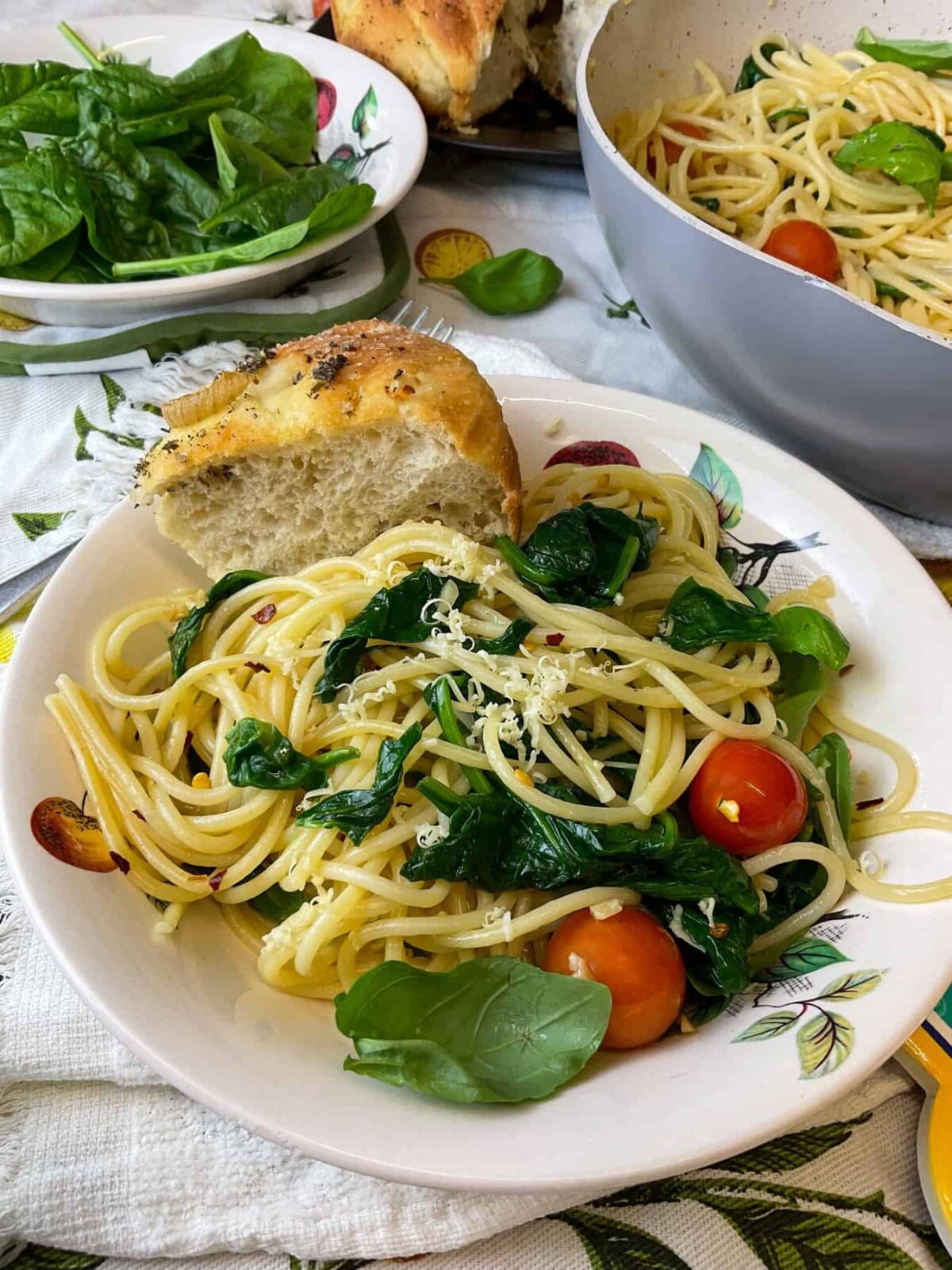
Italian Spaghetti with garlic and olive oil or Aglio e Olio is the perfect summer meal as its packed with fresh ingredients, is light but filling, looks impressive but has an even more impressive name!, yet is a quick and easy meat-free meal. Although, saying that, this dish is also known as 'Midnight Spaghetti' as its a quick and easy meal to rustle up after a night out!
Origin of Italian garlic spaghetti [spaghetti aglio e olio]
Spaghetti Aglio e Olio, or "spaghetti with garlic and oil," is a traditional Italian dish that originates from Naples, in the Campania region of southern Italy. The dish is a classic example of "la cucina povera," or "the poor kitchen," or '' Cibo Povero'' a style of peasant cooking that arose out of necessity and makes good use out of simple, inexpensive ingredients to create tasty, frugal but tummy-filling meals.
Its origins can be traced back to a time when meals needed to be quick, frugal, and easy to prepare. In Italy, and especially in regions like Campania and Tuscany, food has always been about using what's available and affordable and for the working and poorer classes this often meant simple ingredients such as pasta, garlic, and olive oil.
Other examples of Italy's ''la cucina povera'' dishes include the Italian bread salad Panzanella, otherwise known as Poor Man's Salad, Minestrone Soup and Zuppa Di Cavolo which is a traditional cabbage and bean soup.
Spaghetti Aglio e Olio was brought into the spotlight when it made an appearance in the movie "Chef" (2014) directed by Jon Favreau. In one of the scenes, the main character, Chef Carl Casper (played by Favreau), prepares Spaghetti Aglio e Olio for the hostess of his restaurant (played by Scarlett Johansson). This scene is often admired for its sensuality, the way food connects people and elicits emotions, and the beauty of simple cooking.
Spaghetti Aglio e Olio is the perfect recipe to prepare for loved ones on special days for example: Valentines Day [14th February], Lover's Day [24th April], Fathers Day [June 18th for US & UK, September 3rd for Australia], Mothers Days which date [April-May] varies depending on where you live!, International Friendship Day [July 30th], National Couple's Day [August 18th], National Love People Day [September 30th], National I care about you day [October 25th].
And lots more! Including National Spaghetti Day on January the 4th!
How to prepare Italian garlic spaghetti
This Italian Garlic Spaghetti recipe includes cherry tomatoes and spinach but the traditional recipe for Spaghetti Aglio e Olio does not as its a humble, simple dish where the flavours of the garlic and olive oil shine.
So if preferred omit the fresh veggies and just go with dried spaghetti, garlic, and olive oil for an easy delicious dinner.

The olive oil and Napolina spaghetti above in the photo were purchased at our local co-op when they were on special offer, unfortunately we don't have access to other supermarkets on the Scottish Island [the nearest one is over 100 miles away so in total would be over a 200 miles round trip!] so we definitely can't easily shop around!


Cook the spaghetti pasta according to package instructions.
Add the cherry tomatoes and baby spinach leaves to a colander.

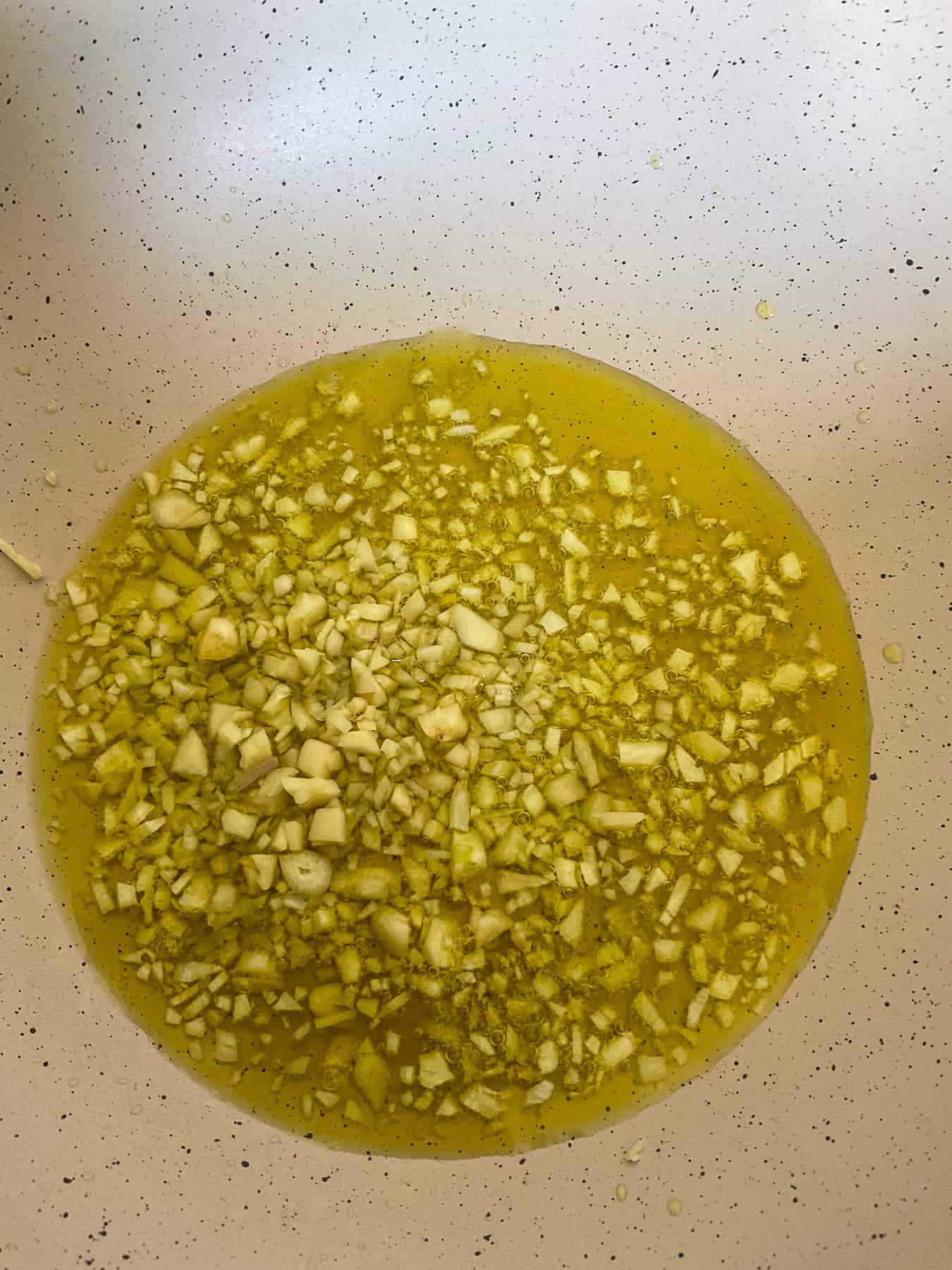
Once the spaghetti is cooked drain the liquid away over the spinach and tomatoes which will wilt the spinach and warm up the tomatoes.
While the spaghetti is cooking, prepare the garlic oil sauce.
Add the sliced and chopped garlic to a pan of hot olive oil and cook for 4 minutes, stirring frequently.
Set the garlic infused olive oil aside on the cooker until the spaghetti is ready.


Add the spaghetti, wilted spinach, and warm tomatoes to a mixing bowl or one of the cooking pots or pans if large enough.
Pour in the garlic oil, and some salt and pepper, and toss everything well together.
Add some red chilli flakes if liked, and a handful of basil leaves.

A squeeze of fresh lemon juice can compliment the sweet garlic flavours of the Italian garlic spaghetti and a sprinkle of grated vegan cheese or nutritional yeast flakes is a delicious addition, although completely optional.
Recipe notes and FAQs
Storage
Store leftover garlic spaghetti in the refrigerator within a covered container for up to 3 days. Or freeze for 2-3 months.
Reheating
Reheat by adding to a non-stick pan and gently reheat, stirring frequently, until hot throughout. A few tablespoons of water can be added to the pan which helps reheat the spaghetti more easily.
Or reheat in a microwave, add a few tablespoons of water to a microwave bowl and stir through the spaghetti. Add a microwave safe cover over the bowl and reheat for 1 minute, stir the spaghetti, and then reheat for a further 2 minutes and repeat until nice and hot.
Pasta, both dried and fresh, can be naturally vegan, but it's not always the case as some varieties include egg.
Many supermarkets, grocery stores, and health food stores carry vegan-friendly dried and fresh pasta options as well as certified vegan pasta products.
Dried Pasta: Most varieties of dried pasta are vegan as its basically just a mix of durum wheat [semolina] and water, although some brands may add extra ingredients so always check the ingredient list to be sure or look for the vegan certification. For example, brands such as Barilla, De Cecco, and San Remo typically produce dried pasta that's vegan, as do most supermarket own brands of pasta such as Asda and Tesco supermarkets.
Fresh Pasta: Fresh pasta is usually prepared with egg as this provides a richer flavour and colours the pasta. Although, many brands and supermarket own varieties are coming out with new vegan fresh pasta products so its always worth a look. For example, brands like Ugo Thrive and Wicked Kitchen offer vegan fresh pasta, and the Co-op's own vegan brand GRO offers fresh ravioli pasta.
Absolutely, you can prepare a gluten-free version of Spaghetti Aglio e Olio by using gluten-free spaghetti or pasta. There are many brands available that offer a variety of gluten-free pasta options, made from ingredients like corn, rice, quinoa, and even beans such as black bean or black bean spaghetti.
Here are some brands available in the UK, US and Australia:
UK:
Doves Farm: They offer a variety of gluten-free pastas including spaghetti, penne, and fusilli. Their products are widely available in the UK.
Freee by Doves Farm: This line offers gluten-free, organic pasta in several shapes.
DS-gluten free: This brand, also known as Schär, offers gluten-free spaghetti and other pasta shapes.
Tesco Free From, Sainsbury's Free From, Co-op Free From, Asda Free From: These supermarket chains offer their own line of gluten-free products, including pasta.
US:
Barilla Gluten Free: Barilla, a well-known pasta brand, has a line of gluten-free products that includes spaghetti, penne, and other shapes.
Ancient Harvest: This brand offers gluten-free spaghetti made from corn and quinoa.
Tinkyada: They make a variety of rice-based, gluten-free pasta products, including spaghetti.
Trader Joe's: They have their own line of gluten-free pasta products made from ingredients like brown rice and quinoa.
Banza: This brand makes gluten-free pasta from chickpeas, which has the added benefit of being high in protein.
Jovial: This brand offers a variety of gluten-free pasta, including brown rice spaghetti.
Australia:
San Remo: This brand has a line of gluten-free pasta in various shapes, including spaghetti and penne. They are widely available in Australia.
Buontempo: This brand offers a range of gluten-free pasta, including rice spirals and rice penne.
Orgran: Orgran produces a variety of gluten-free products, including several different types of pasta like buckwheat pasta and vegetable rice pasta.
Casalare: They produce gluten-free pasta including spaghetti, fusilli, and macaroni.
Simply Wize: This brand offers a range of gluten-free products including gnocchi and spirals.
Barilla Gluten Free: Barilla is an international brand and also offers a range of gluten-free pasta options in Australia.
Coles and Woolworths supermarkets also have their own brand of gluten-free products which include pasta.
As with all shop-bought products always have a careful look at the ingredient lists and check for a gluten-free certification, just to be sure.
Traditionally spaghetti, which is long thin strands of pasta, are used for a traditional Aglio e Olio but technically any type of pasta can be used for this dish including the bag of pasta that is currently in your pantry!
Linguine: Similar to spaghetti but slightly flatter, linguine works well with olive oil-based sauces.
Fettuccine: A bit wider and thicker than spaghetti, fettuccine can provide a different texture but would still work well with the simple garlic and oil sauce.
Bucatini: This is a long noodle like spaghetti but has a hole running through the center. It can be a fun variation to try.
Angel Hair (Capellini): This is a very thin version of spaghetti that would cook quicker and provide a more delicate texture.
Penne, Rigatoni or Fusilli: If you prefer short pasta, these could be good options. The ridges in penne and rigatoni, and the spirals in fusilli can help hold onto the sauce.
For a classic Spaghetti Aglio e Olio the choice of oil does matter as olive oil is a main part of the flavour profile, however olive oil can be expensive so if its not available try one of these oils:
Canola Oil: Also known as rapeseed oil, this is a mild-flavoured and versatile oil.
Sunflower Oil: This oil is also mild in flavour and can withstand high heat, making it a good choice for sautéing.
Grapeseed Oil: This oil has a relatively high smoke point and a mild flavour that can make it a good substitute for olive oil in cooking.
Avocado Oil: It has a high smoke point and a mildly buttery flavor that can complement the garlic well.
Peanut Oil: While it has a slightly more pronounced flavor, it can be used if other options aren't available. However, it could alter the flavour profile of the dish.
Safflower Oil: Another oil with a high smoke point and a light, neutral flavour.
If possible buy a bottle of olive oil whenever it is on special offer at your local store or supermarket as it may be a few pounds or dollars up front, but it can make a big difference to certain meals and elevate a simple salad into something special, and a bottle will last a while especially if just kept for extra special recipes.
But in a pinch, any of these suggested alternative oils can be used instead of olive oil. Just keep in mind to adjust your cooking temperature according to the smoke point of the oil you choose.
If your on an oil-free diet then try one of these oil-free suggestions:
1. Replace the oil with a vegetable broth [stock] or water. Sauté or gently simmer the garlic in the broth over a low heat to avoid sticking to the pan. It may not provide the same richness as oil, but it will still infuse the garlic flavour into the broth. Use the garlic broth by mixing it with the spaghetti, spinach, and tomatoes as per the recipe.
2. Use a nut or seed butter, such as almond, peanut, or sunflower or tahini, thinned out with a little water or broth. This will create a creamy sauce that can be infused with garlic in the same way as the vegetable broth above. While the flavour profile will be different from traditional Spaghetti Aglio e Olio, it can be a delicious alternative.
3. Aquafaba: This is the liquid in a can of chickpeas and it can be used in a variety of plant-based cooking methods. It’s mostly flavourless, so it won't interfere with your garlic flavour. Sauté the garlic in the aquafaba, and perhaps add the chickpeas that came from the can to the finished dish as well.
4. Silken Tofu: Silken tofu can provide a creamy texture. Blend the tofu to make it creamy before using it to sauté the garlic slices.
5. Roast Garlic Bulb: roast an entire bulb of garlic, pop the insides of each garlic clove and using a cutlery fork whisk or mash the roasted garlic through some of the spaghetti cooking water or some vegetable broth. This mixture could also be simmered for a few minutes to infuse the garlic with the broth. See the next question below for how to roast a garlic bulb.
Remember, if you choose a replacement that has a more distinctive flavour (like the nut or seed butter), it will likely affect the overall taste of the finished spaghetti dish.
Also, to compensate for the lack of olive oil flavour, for some of the suggestions above, stir a teaspoon of white miso paste or a few tablespoons of nutritional yeast flakes through the cooked garlic mixture to add extra tasty umami flavours.
Please note, that we have not yet tested the recipe with the above suggestions so its all experimental, as indeed it was with our ancestors throughout history preparing and inventing new meals with whatever food they had available!
Your finished dish will still be tasty and good cooking is all about having fun and experimenting so that the finished meal fulfils your own individual preferences and needs.
Preparing a whole garlic bulb for roasting in the oven is straightforward although for the sake of energy efficiency, consider adding the garlic bulbs to the lower shelf of the oven whenever you're baking a savory dish.
1. First, preheat the oven to 160 Fan / 180 C / 356 Fahrenheit / Gas 4. [If preferred you can turn the heat up a notch].
2. Peel the loose papery pieces of garlic away from the bulb.
3. Slice the top of the garlic bulb so that you can see the individual cloves, being carefully not to slice too far down the bulb.
4. Wrap the garlic bulb in aluminium foil or kitchen foil. Alternatively, instead of foil use parchment paper firmly wrapped around the bulb, or even better a small ramekin dish or mini hot pot or casserole dish with a lid, or if available use a ceramic or terracotta garlic baker which are specifically designed for roasting garlic bulbs.
5. Place the wrapped garlic onto a baking tray and roast for 35-45 minutes or until the garlic is soft throughout.
6. Once the garlic is cool the cooked garlic should be easy to squeeze out of each clove.
7. The garlic can now be used for a recipe, stored within an air-tight container in the refrigerator for up to 2 weeks, or frozen for a few months. If possible, freeze in ice-cube trays then once frozen pop the garlic cubes out and store in a freezer bag.
8. The roast garlic is perfect for pasta sauces, soups, stews, curries, tagines, home-made garlic butter [simply mix through your usual plant-based margarine or butter], home-made garlic bread [stir the garlic through some margarine, butter or oil and use to coat a baguette, etc, before cooking], and lots more!
Preventing the garlic from burning is an important step when preparing dishes like Spaghetti Aglio e Olio where the flavour of the garlic is a key, so here are a few tips:
Low Heat: Cook the garlic on low to medium heat as a higher heat can cause the garlic to burn very quickly.
Continuous Stirring: Keep the garlic moving in the pan as this will ensure that it cooks evenly and doesn't have time to sit on the hot surface of the pan and burn. The garlic cooks in just a few minutes so there's no need to stand at the stove for lengthy periods of time.
Timing: Add the garlic to the pan at the right time so if you're cooking it with other ingredients, make sure to add the garlic later in the process, as it cooks faster than most other ingredients.
Size of Cut: If you chop your garlic into larger pieces, it will take longer to cook and therefore be less likely to burn. Finely chopped or minced garlic cooks faster so has the potential to burn much quicker.
Watch Closely: Garlic can go from perfectly golden to burnt very quickly so its best to stay with the pan and remove the garlic from the heat as soon as it's lightly golden. The garlic will continue to cook in the pan due to the residual heat so undercooking it slightly and then removing the pan from the heat is a good idea.
Use of Oil: Make sure the garlic is fully coated in oil, which will help to distribute the heat more evenly protecting it from burning.
Burnt garlic can turn bitter and can overpower the flavour of your final dish, so it's always better to err on the side of undercooking rather than risk burning it.
Garlic Powder or granules: This can be a suitable replacement for fresh garlic although keep in mind that the flavour will not be as fresh, but it will still add a strong garlic flavour. Use about a quarter [¼] teaspoon of garlic powder for each clove of garlic called for in the recipe.
Jarred Minced Garlic: This is another option, although like garlic powder, the flavour won't be quite as good as fresh, use a half teaspoon of jarred minced garlic for each clove used in a recipe.
Garlic Flakes: Similar to garlic powder but dehydrated and flaked, use a half teaspoon of garlic flakes for each clove of garlic.
Garlic Salt: In a pinch, you could use garlic salt, but you should reduce any other added salt in the recipe to avoid making it overly salty. Use a quarter [¼] or half [½] teaspoon of garlic salt for each clove of garlic called for.
Garlic Paste: Usually found in tubes or jars in the produce or shelf section of the supermarket or grocery store, it can be used in the same quantity as fresh garlic.
Yes, you can definitely use store-bought frozen garlic as a substitute for fresh garlic. This is a great option as it retains more of the flavour and aroma of fresh garlic compared to dried alternatives like garlic powder, granules or garlic flakes.
Frozen garlic is usually available in cubes or in a chopped form. As a rough guide, one cube or teaspoon of frozen chopped garlic is generally equivalent to about one clove of fresh garlic, although do check the packaging for any specific instructions.
Of course, the cherry tomatoes and spinach can be replaced with anything you prefer. We've included a few suggestions below but some of these may need to be cooked before adding to the spaghetti:
Other Greens: You could try using other greens such as kale, spring greens, beet greens, swiss chard, cabbage, or rocket [arugula].
Vegetables: Bell peppers, zucchini [courgettes], asparagus, peas, mushrooms, or even a mix of your favorite vegetables could work well. If you like a bit of crunch, you could add thinly sliced raw radishes or cucumbers just before serving.
Protein: Adding some Crispy Tofu Bites can make the dish more filling by providing extra protein, or go for a pulse such as chickpeas, butter beans or cannellini beans.
Vegan Cheese: While not a traditional addition to Aglio e Olio, adding a sprinkle of grated vegan cheese, or a bit of crumbled vegan feta, or a scoop of vegan cream cheese, or a few tablespoons of nutritional yeast flakes, can add a burst of flavour.
Nuts and Seeds: Toasted walnuts, flaked almonds, crushed cashews or peanuts, or even a sprinkle of sesame seeds can add a nice texture and more protein.
Herbs and Spices: Fresh herbs like parsley, thyme, basil, dill, chives, oregano, or spring greens [scallions/green onions] could be nice additions. Spices like crushed red pepper or red chilli flakes can add a bit of heat.
Olives or Capers: These can provide a nice salty umami boost to the dish.
Spaghetti Aglio e Olio is a meal in itself but if sides are desired then the perfect accompaniments are perhaps crusty bread, baguette, garlic bread, or focaccia with perhaps a nice crisp salad or this Italian Bread Salad Panzanella.
Or for a more substantial side go for some roasted or pan fried vegetables such as asparagus, bell peppers, courgettes [zucchini], aubergine [eggplant], mushrooms, butternut squash, Brussel sprouts, broccoli, or sweet potato. A mix of these veggies would make a tasty sheet pan roasted veggies dish with perhaps a can of drained chickpeas stirred through for extra protein.
Leftover home-made Ratatouille would also be a delicious flavour-packed side, as ratatouille can be used as a chunky relish or salsa.
Another idea is some Crispy Tofu Bites which would be a delicious protein filling accompaniment or for some crunch bake a batch of our easy home-made vegan crunchy croutons, the recipe is over on our Cream of Swede [rutabaga] Soup recipe post.
Lastly, consider having a tasty vegan soup for a starter such as this Easy Budget-Friendly Tomato Soup, or this Slow Cooker Yellow Split Pea Soup, or this Easy Carrot and Cumin Soup.
The best answer for what to do with leftover Spaghetti Aglio e Olio is to simply reheat it and eat it quickly! As other family members will likely want the leftovers as well!
A few more ideas:
Pasta Salad: Toss the cold Spaghetti Aglio e Olio with fresh salad veggies such as tomatoes, cucumber, lettuce, salad leafs, olives, and some fresh herbs. Add a few tablespoons of white wine vinegar,or your preferred vinegar, or a squeeze of fresh lemon juice, and extra olive oil if liked. Cubes of vegan feta cheese is a nice addition.
Stir-fried Noodles: Heat up a large deep fry pan, skillet, or wok, add some vegetables (like bell peppers, broccoli, snap peas, mangetout, baby corn, mung bean sprouts, Pak choy, etc) and stir-fry until soft but still crisp, then toss the leftover Spaghetti Aglio e Olio through the veggies and stir-fry some more to heat the spaghetti. Then you could add soy sauce or gluten-free tamari, sesame oil, or a little chili sauce or sweet chilli sauce for extra tastiness.
Pasta Soup: Chop the spaghetti into smaller pieces and add it to a Minestrone soup or any tomato based soup or heat up vegetable broth, add vegetables, beans, or lentils of your choice, and when everything is cooked, stir through the chopped spaghetti along with its garlic sauce, and any wilted spinach, tomatoes, etc. Heat for a couple more minutes until everything is warmed through.
Pasta Bake: Mix your leftover Spaghetti Aglio e Olio with some tomato sauce or a vegan creamy white or cheese sauce, add some cooked veggies, top with vegan cheese if desired, and bake in the oven until everything is heated through and the top is a nice and crispy melted.
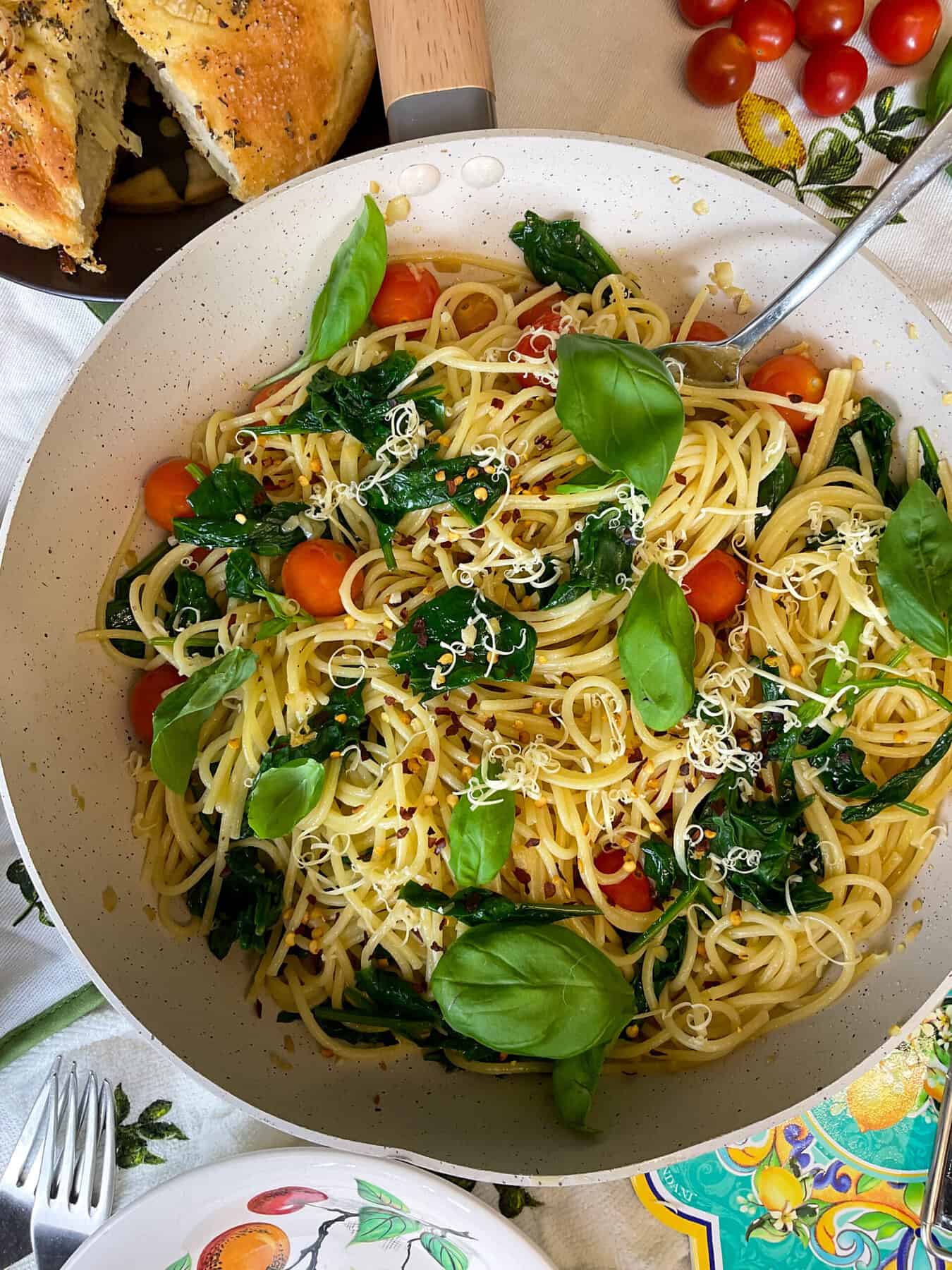
We enjoyed out Spaghetti Aglio e Olio with a sage and onion focaccia bread. The focaccia bread dough was prepared with our bread machine and finished in the oven. This vegan focaccia recipe is so easy and delicious our absolute favourite, so if you'd like the recipe then do send us an email and we'll share the recipe!
More delicious easy Italian vegan dinner ideas
Traditional Italian or Italian inspired meals are perfect for rustic, budget-friendly, meat-free family meals that can be easily adapted to what you have available, which is why our collection of Italian inspired vegan recipes keep on coming!
My family is especially loving this Italian Bread Salad, otherwise known as Panzanella or Poor Mans Salad as the warmer months approach, and for chuck-it-in-the-pot quick meals you can't get better than this Italian Cabbage and Bean Soup otherwise known as Zuppa Di Cavolo and this classic everyone's favourite Minestrone Soup.
And for a slow cooker gem this Green Lentil Spaghetti Bolognese usually makes an appearance in our slow cooker at least every couple of weeks!
***please note: for US measurements click the 'US customary button' within the recipe and the measurements will switch to tablespoons, cups, and ounces.***
📖 Recipe

Italian Garlic Spaghetti [Spaghetti Aglio e Olio]
Equipment
- Large Saucepan for cooking spaghetti
- Non-stick skillet, fry pan or similar, for cooking garlic in oil
- Colander, for draining hot pasta
Ingredients
- 400 grams dried spaghetti pasta [use gluten-free if necessary]
- 8 garlic cloves sliced and rough chopped, no need to be fine diced, [or 1 whole small garlic bulb, our whole bulb weighed about 40g]
- 4 tablespoons olive oil
Optional: [but highly recommended]
- 115 grams baby spinach leaves [or ordinary spinach shredded into smaller pieces]
- 250 grams cherry tomatoes [or larger tomatoes chopped into bite size chunks]
Garnish, optional
- small bunch of basil leaves, dried chilli flakes, fresh lemon [for zest or juice]
Instructions
Cook the spaghetti:
- Cook the spaghetti according to the package instructions.400 grams dried spaghetti pasta
- Place the spinach and cherry tomatoes into a colander.[If preferred the spinach can be simply tossed through the cooked and drained spaghetti rather than having the spaghetti water drained over it.]115 grams baby spinach leaves, 250 grams cherry tomatoes
- Once the spaghetti is cooked drain the liquid over the spinach and tomatoes in the colander. This will wilt the spinach and warm the tomatoes.
While the spaghetti is cooking prepare the garlic oil sauce:
- Heat the oil over a medium heat in a non-stick pan for a few minutes, and once hot add the garlic and turn the heat to low.8 garlic cloves, 4 tablespoons olive oil
- Stir and cook the garlic for 4 minutes, but don't let the garlic go too brown as it will affect the flavour and may result in bitter tasting garlic. [If the garlic starts to turn colour before the 4 minutes are up, carefully remove the pan over to a cold part of the stove top, and stir the garlic until the 4 minutes are up,]
- Once cooked remove the pan from the heat and set aside onto a cool area of the cooker, the garlic will continue to cook for a short while so give it a stir once in a while until the spaghetti is ready.
Assemble the dish:
- Place the spaghetti, wilted spinach and warm tomatoes into a mixing bowl or into the spaghetti or garlic cooking pan if its large enough. Pour in the hot garlic oil and season with enough salt and pepper to bring all the flavours together. Toss everything together well, adding a few pinches of red chilli flakes if liked and half of the bunch of basil.small bunch of basil leaves, dried chilli flakes, fresh lemon [for zest or juice]
Serve:
- Scatter the extra basil leaves over each serving. Nutritional yeast flakes or grated vegan cheese is a nice addition and so is a squeeze of fresh lemon juice or a sprinkle of fresh lemon zest.
Notes
- Nutritional data is for guidance only and is not intended as an exact calculation as ingredients vary.
- Store leftovers for up to 3 days.
- Or freeze for 2-3 months.
- Reheat by adding to a non-stick pan and gently reheat, stirring frequently, until hot throughout. A few tablespoons of water can be added to the pan which helps reheat the spaghetti more easily.
- Or reheat in a microwave, add a few tablespoons of water to a microwave bowl and stir through the spaghetti. Add a micro-wave safer cover over the bowl and reheat for 1 minute, stir the spaghetti, and then reheat for a further 2 minutes and repeat until nice and hot.
- For a gluten-free garlic spaghetti, use a gluten-free spaghetti pasta or other g-f pasta shape.
- The cherry tomatoes and baby spinach leaves are optional as the classic dish does not require them, but they do add extra nutrition and tasty textures.
- Tip: chop the garlic at least 10 minutes before requiring for the recipe as this activates the health boosting enzyme allinase in garlic.
- For an even stronger garlic flavour stir through 1-2 teaspoons of garlic powder or granules through the spaghetti as its being tossed.
- For ideas on olive oil replacements including potential oil replacements for those on oil-free diets have a look at our recipe notes and FAQ section above the recipe.
Nutrition
Prepared our Italian Garlic Spaghetti? We would love to know how you got on with the recipe. It would be wonderful if you could leave a comment below and rate the recipe. Thanks so much, Jacq x
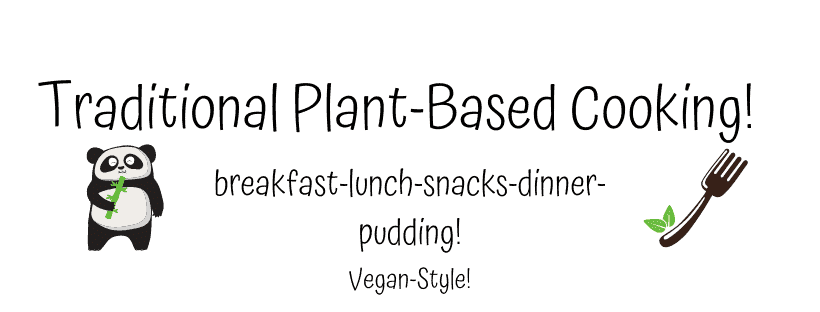

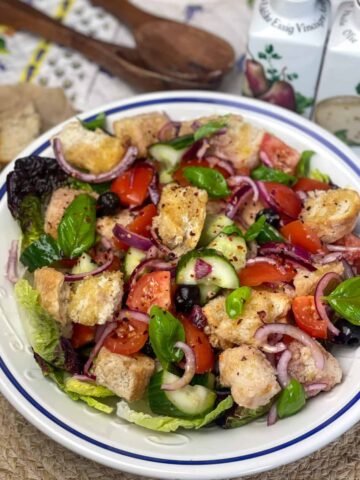
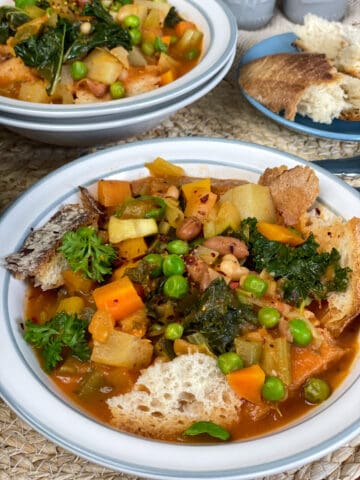
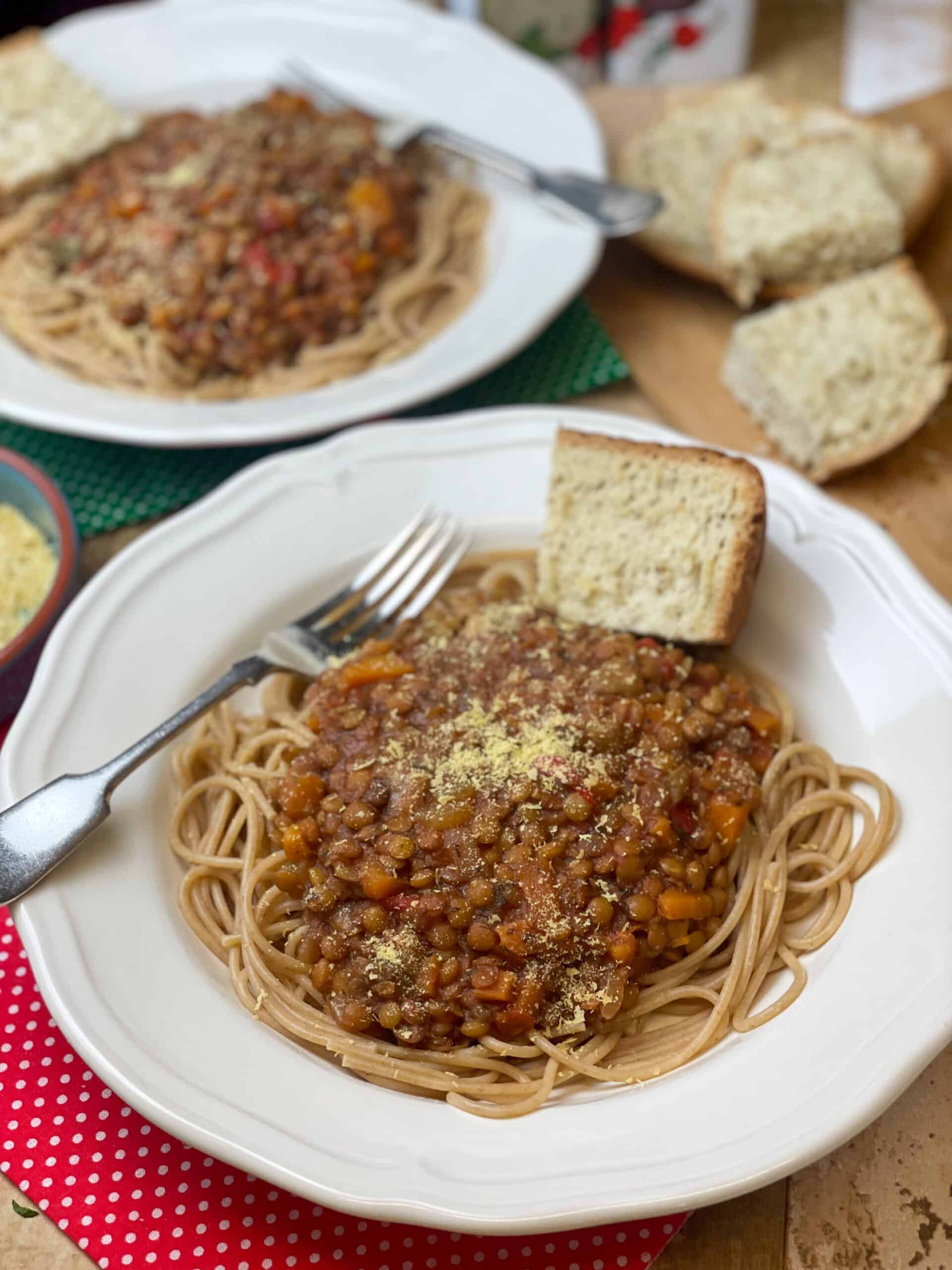
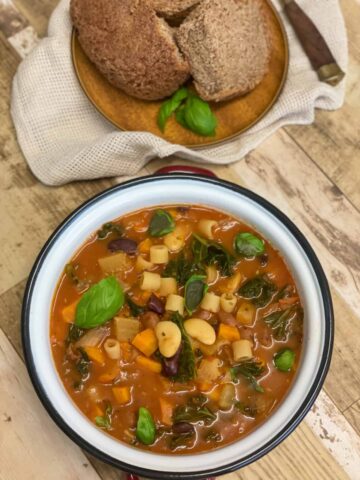
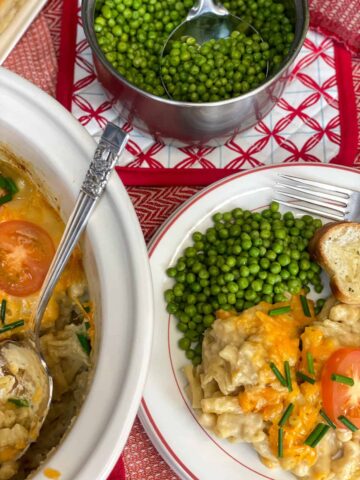
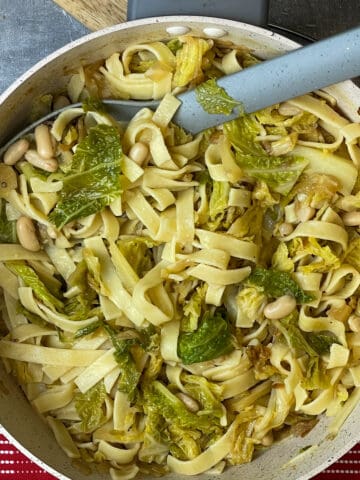

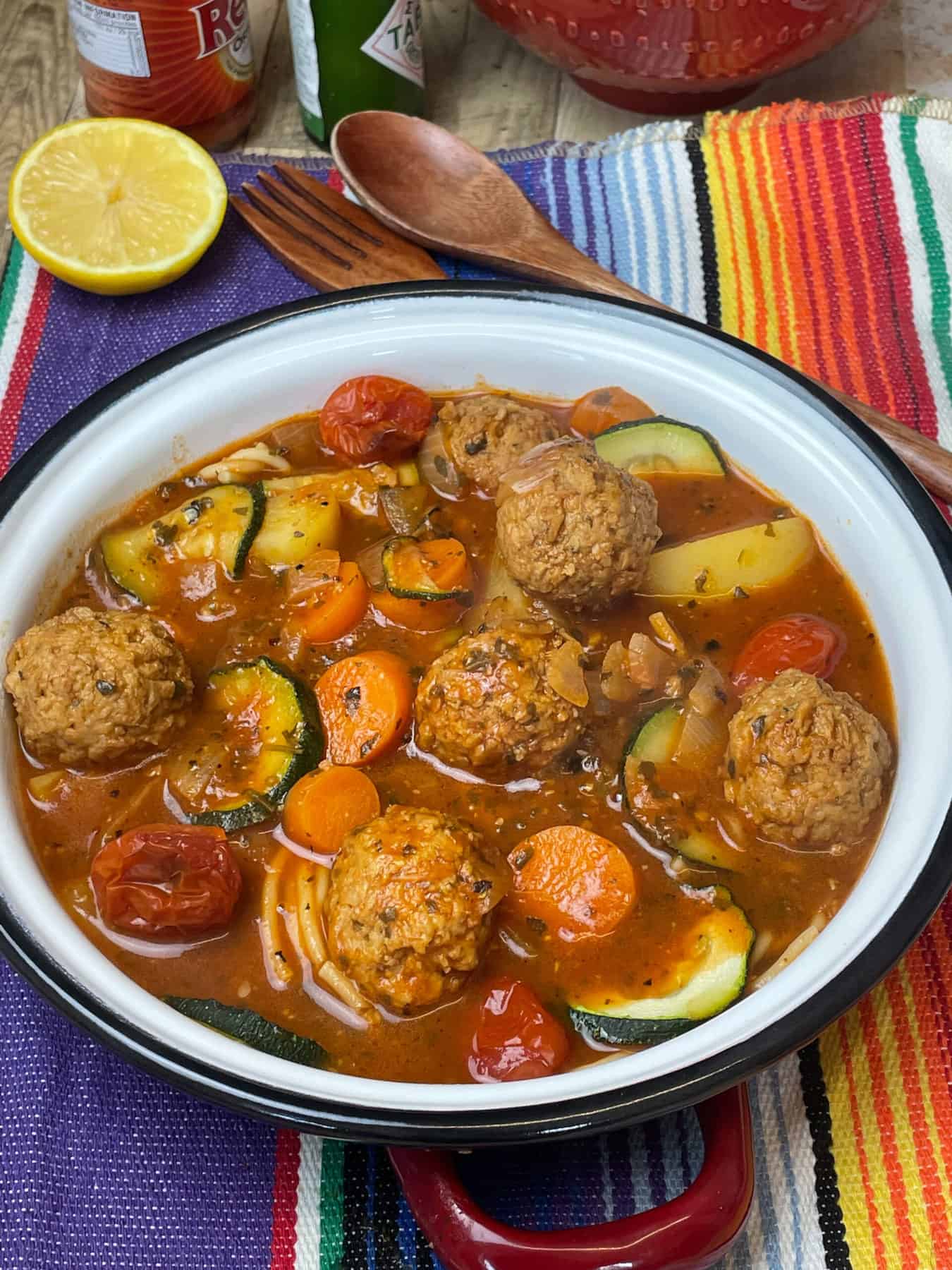
Leave a Reply